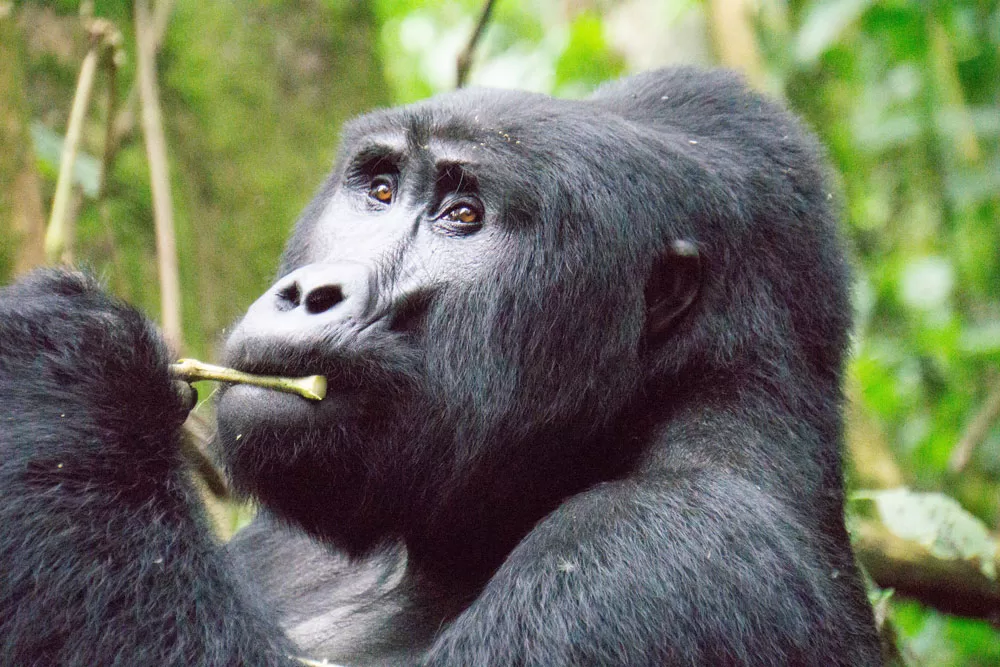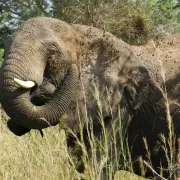
History of Gorilla Viewing
Gorilla mania is not a recent phenomenon, as you might think. A long succession of fascinating individuals has fallen under the spell of mountain gorillas.
The first scientist to study gorillas in their natural habitat was Carl Akeley from the American Museum of Natural History. He embarked on a journey to the Virungas, where he collected a family group of gorillas, which is now on display in an excellent habitat exhibit in New York. Akeley became captivated by gorillas and fell in love with their mountain habitat. In 1926, he returned to the Virungas but tragically passed away shortly after starting his work. He was laid to rest beneath the spire of Mikeno volcano, in what was then the Belgian Congo.
After World War II, Walter Baumagartel settled in the village of Kisoro, Uganda. He opened a lodge near the volcanoes Sabiny, Muhabura, and Gahinga. By the late 1950s, his Travelers Rest House became known as a destination for witnessing gorillas in the wild. His guide, Reuben, was a celebrated gorilla tracker who led many clients on the trail of these apes. At that time, the gorillas were not accustomed to human presence, and fortunate visitors could only catch a fleeting glimpse of them. When pursued, the silverback gorilla would charge, and witnessing this hair-raising display became a major attraction for visitors. Eventually, it was revealed that the charge was a scary bluff, and if pursuers stood their ground, the huge male would retreat.
One of the visitors to Baumagartel’s lodge was George Schaller, a young American biologist. He spent a year in the Virungas, residing in Carl Akeley’s former campsite beneath Mikeno. Schaller was a new breed of biologist, specializing in ethology, the study of animals in the wild. His pioneering research demonstrated that gorillas were gentle creatures capable of tolerating human observation when habituated to undisturbed contact.
Schaller was succeeded by Diana Fossey, an amateur naturalist who volunteered to study mountain gorilla behaviour at the request of anthropologist Louis Leakey. She initially began her work on the Zaire side of the volcanoes but later moved to Rwanda. For nearly fifteen years, she lived at Karisoke Research Station, which she established, in the rain-soaked Hagenia forest between Karisimbi and Visoke volcanoes. Fossey developed a method for observing gorillas, allowing the animals to accept her presence and behave naturally. She gained complete acceptance from several gorilla groups. Her research revolutionized the public perception of these great apes, shifting them from being seen as savage King Kong-like killers to persecuted gentle giants, a portrayal closer to reality.
Fossey’s groundbreaking research drew significant attention to the plight of mountain gorillas. In the mid-1960s, half of Parc des Volcans was opened up to human settlement and agriculture, leading to the potential excision of more parkland. In response, a coalition of international wildlife organizations formed the Mountain Gorilla Project. The plan aimed to preserve the park by demonstrating its economic value as a gorilla habitat through tourism development.
To make gorillas accessible to tourists, several gorilla groups were deliberately habituated to human presence. Strict rules for permits and viewing procedures were established. Park guards and gorilla guides received extensive training, and a robust public education program began to instil a sense of pride and economic potential associated with gorilla conservation among the local population.
Since the introduction of gorilla tourism, the situation for both the animals and the park has dramatically improved. Thousands of people have visited to experience gorilla encounters, with a strong emphasis on maintaining the dignity of both gorillas and tourists. The park’s revenue now surpasses its costs, allowing for an expanded ranger staff and park development.
Ironically, Diana Fossey vehemently opposed the development of tourism in the park. She was concerned about disturbing the gorillas and believed they should be protected for their intrinsic value, not turned into tourist attractions. Some even say she considered the gorillas as her own or preferred them to people. She was known for her abrasive personality, which didn’t always fit the social norms of urban settings. There’s a story that she refused to allow the president of Rwanda to visit one of her study groups, fearing the gorillas might become accustomed to the scent of local people, who were often poachers. While this tale may be apocryphal or exaggerated, it’s undeniable that Fossey’s actions sometimes created friction with the local population. She frequently confiscated cattle found in the park and destroyed snares set for small antelopes. Her strongest opposition was directed at poachers targeting gorillas, whether for profit from selling infants or simply for sport. Such poachers had killed her favourite gorilla, Digit. Tragically, Diana Fossey herself may have met the same fate. In the waning days of 1985, she was brutally murdered in her cabin and buried near Digit in the Hagenias of Karisoke.
While “Gorillas in the Mist” (Universal Studios and Warner Brothers, 1988) depicted Diana Fossey’s character in a highly dramatic fashion, the film effectively addressed her unwavering commitment to the survival of mountain gorillas and the broader issues surrounding their conservation.
Recent Posts
History of Gorilla Viewing
Best Time To Visit Uganda
Things To Do In Uganda
All Categories

Thailand





